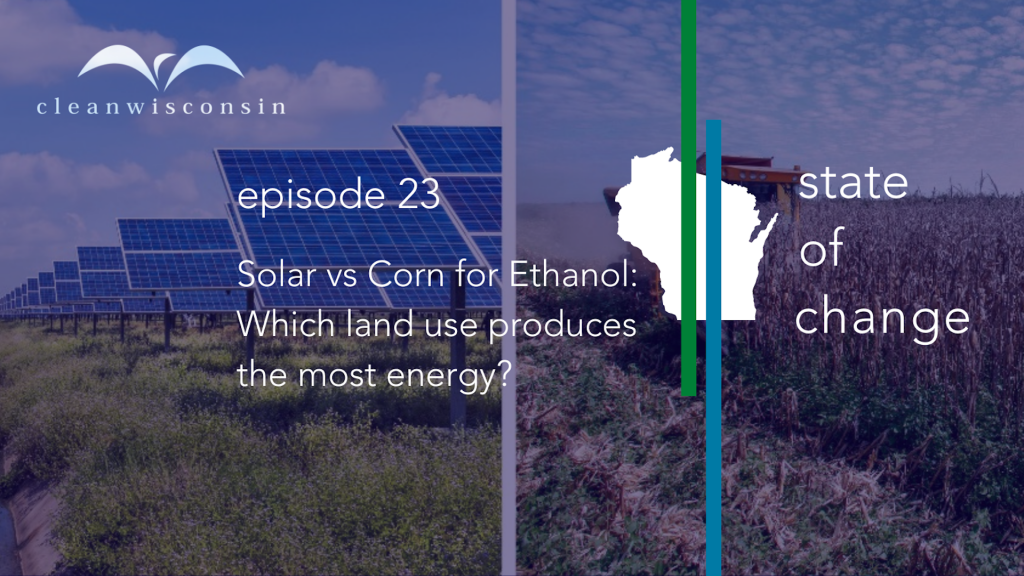We’re hearing it more and more: Solar farms in Wisconsin are taking away prime farmland used for food. But it turns out, a million acres of farmland in Wisconsin are already being used energy production by growing corn for ethanol. A quarter of all the corn grown in our state is processed into ethanol. Nationwide, it’s 45%.
But which land use produces the most energy per acre, corn or solar? And how much land do we really need for solar in Wisconsin to end our reliance on coal and gas? Hear from Clean Wisconsin Science Program Director Paul Mathewson, Ph.D., about his latest analysis that’s been getting a lot of attention.
Host: Amy Barrilleaux
Guest:
Dr. Paul Mathewson, Science Program Director, Clean Wisconsin
Background Reading:
- Corn Ethanol vs. Solar: A Land Use Comparison
- Wisconsin’s Roadmap to Net Zero report
- Modeling shows Koshkonong Solar Energy Center will improve the health of nearby waterways
- Clean Wisconsin Science Program page
Where to Listen:
Full Transcript:
Amy Barrilleaux: When it comes to using land for energy, Wisconsin’s million acres of ethanol corn dwarf the 3,500 currently set aside for solar. A new detailed analysis from Clean Wisconsin shows we could be getting far more energy on less land, by embracing solar farms instead of ethanol.
Joining me is Clean Wisconsin science program director Paul Mathewson whose team looked how we’re using our land in Wisconsin to produce energy.
You found out that, acre for acre, solar produces a hundred times more energy than corn grown ethanol. That’s a big number. So I want to take a deeper dive here. What did you have to look at to figure that out.
Paul Mathewson: Yes, so there are a few different things we found, and I’ll kind of step through them. Whenever you’re trying to compare dissimilar of things, there’s no perfect comparison. What’s the most similar thing that we can compare with photovoltaic solar energy to ethanol production? And that is vehicle miles powered, because you can use solar panels to power electric vehicles, and then ethanol is mixed in with gasoline to fuel internal combustion engines. There have been a number of analyses looking at, okay, on a per acre basis, how many miles can we power a gas engine with ethanol versus if we use that same acre for solar? How many electric vehicle miles can we power? And when we do that comparison, it’s anywhere between at the low end, you get 60 times more vehicle miles powered with solar compared to ethanol, all the way up to–some estimates are over 200 times the amount of vehicle miles you can power with solar compared to ethanol on the same amount of land. A big chunk of that is due to the fact that electric vehicles are so much more efficient than internal combustion engines. But even when you look at if we convert that ethanol into electricity and then power an electric vehicle, you’re still talking at least 30 times more miles powered with solar than with ethanol.
Amy Barrilleaux: In the analysis, you also talk about something called “energy return on investment” or looking at what it takes to actually produce the ethanol or make all those solar panels. And that’s when solar really started to separate, I think, from ethanol in terms of which is the better energy source.
Paul Mathewson. Yes, so how much energy you need to put in compared to how much energy you are getting out of the system. So with corn for ethanol, there’s energy involved in the fertilizer, in the planting and the harvesting, and the production of the ethanol. So when you’re looking at the net energy benefits of ethanol, you’ve got your gross energy that you can get out of the ethanol at the end. But then you’ve got to subtract how much energy you put in. 80% of that energy that you’re producing with ethanol is offset by energy inputs. So basically you’re only getting a net benefit of 20% of that energy going to society because of all the inputs that go into it. Whereas with solar, it’s about 12% of the output is offset by inputs. So 88% of the energy is a is a net energy gain that you’re getting from solar. When you apply that that net those net energy figures to solar energy production versus ethanol energy production, you get 100 to 125 times more net energy per unit land with solar panels versus using that same land to farm corn to produce ethanol.
Amy Barrilleaux: Now, I know ethanol is not food, but it’s kind of part of our food chain because the byproducts or the leftover products from ethanol production are used in animal feed. So you took this analysis one step further and looked at, okay, what if that entire stalk of corn, all of it was used in some way, either for animal feed or for energy. And still solar came out on top. Were you surprised at that?
Paul Mathewson: Yeah, I don’t know if I was surprised. I was surprised at how much more efficient solar panels still were, even if we if we just look at the pure amount of energy that’s in a corn stock and assume all of that can go into some societal benefit. Solar still comes out 15 to 17 times more efficient at producing energy. And I think, you know, that just comes down to the fundamental limitations of photosynthesis in the in the corn plant. The other thing that stood out to me was the fact that the efficiency of solar has been continuing to increase. It is increased by 30% in the last decade. I’m sure there’s a cap to the amount of technological improvement there can be, but we continue to see solar get more and more efficient.
Amy Barrilleaux: A million acres of corn are being grown for ethanol in Wisconsin. Is there a need for a million acres of solar in Wisconsin right now? And how close are we to being anywhere near that?
Paul Mathewson: Right. That’s another thing that we looked at in Wisconsin in our analysis using estimates for how much utility scale solar that we’re going to need to meet our carbon free by 2050 goals. There are a couple of different analyses that we’ve seen in the state. We’re going to need about 300,000 acres of utility scale solar to meet our needs. So we wouldn’t even need that full million acres that’s already been used for corn ethanol. And so that 300,000 acres translates into less than 3% of our total agricultural land in the state. It’s less than a third of what we’re already using for ethanol. It’s also a more nuanced discussion because it’s not simply a matter of just replacing any land that’s used for corn, for ethanol, because some of that might be really good prime farmland. And so the bigger point we wanted to make was, you know, solar isn’t going to be 10%, it’s not going to eat 20% of our agricultural land. It needs 3%. And can we find 3% of our farmland that is marginal quality. You know, it’s not it’s not great for crops, but we’re growing them out there because that’s was a good land use for it. Can we find within that 3% farmland that is disproportionately contributing to water quality issues, you know, land that’s near waterways, that’s susceptible to erosion or requires a lot of inputs to get harvests that were worthwhile on that land? Can we find these marginal lands? Could you find these disproportionately impacted lands to site the solar so that we can maximize the environmental co-benefits of solar production?
Amy Barrilleaux: Let’s talk about those co-benefits for a minute. Conventional agriculture, especially corn, is a major contributor to water pollution issues in Wisconsin. Harmful nitrates, phosphorous, soil runoff. You have research, other research, showing that there’s actually a water quality benefit for nearby lakes and streams when a conventionally farmed cornfield is taken out of production and solar is put there instead. Why is that? What’s going on?
Paul Mathewson: So around the solar panels, it’s very common to have a perennial grass layer that holds the soil in place. And when you have that perennial vegetation in place, it’s not being turned over once or twice a year, and that soil is going to stay in place better. It’s going to hold the particles, and you’re going to have less runoff into nearby waterways. And then you don’t have the same fertilizer and pesticide applications year after year that you would have with a cornfield. So you’re not going to have the same inputs going onto the land, and then you’re not going to have the same erosion off of the land when you can have that well-developed perennial vegetation under and around the panels. The other environmental benefit that we talk about with solar facilities is the potential to establish pollinator habitat. So pollinators like bees and butterflies, they’ve been declining around the globe and in Wisconsin. Some of them are even endangered, like the Rusty Patched Bumblebee, due to habitat loss and due to pesticide use. And a lot of that is agriculture expansion. You know, this land didn’t used to be agricultural land 150 years ago. It’s been converted. All that habitat loss and all the pesticides are decimating the pollinator populations. So what a number of [solar] facilities do to make it more environment friendly is plant pollinator-friendly habitat around the margins of the facility. You’re adding that additional habitat that that was lost that you don’t have with traditional row crop agriculture.
Amy Barrilleaux: I think it’s surprising, though, because corn seems natural and solar panels definitely are not. But you’re saying that solar farms can be better for the land because of all these water quality benefits.
Paul Mathewson: Yes, and it all and it really does come down to making sure that the vegetation management in the solar facility is good. If they don’t put it in the vegetation, then we’re not going to see those. And so that’s what we’re continually advocating for when we support these facilities. Looking at the vegetation management plan and making sure it’s as strong and robust as it can be just to make sure we do realize these benefits.
Amy Barrilleaux: What should people do if they hear that a solar farm is being proposed for their area to make sure that they are going to get the most environmental benefit from it? Should they, I guess, be advocating for pollinator habitat there?
Paul Mathewson: Yes. And my understanding is that when they propose these sites, they do community outreach, they hold open houses. So definitely participate there, make your voice heard. I have not seen a recent proposal that doesn’t have a good vegetation management plan. Maybe ten years ago they would do just gravel or, you know, they wouldn’t vegetate it. But I have not seen a proposal that doesn’t have a good, robust plan to put in and get quickly established a permanent grass layer. But definitely make your voice heard that, you know, we want that, we want it to be as environmentally friendly as possible. We want that pollinator habitat.
Amy Barrilleaux: Paul Mathewson, thank you so much for sharing your insights into all this. This entire analysis, looking at corn ethanol and solar, is available online. Just head to cleanwisconsin.org. can find plenty of other studies and information on our science page. You’ve been listening to State of Change for Clean Wisconsin. I’m Amy Barrilleaux.
Like “State of Change”?
Subscribe to State of Change on Apple Podcasts, Google Play Music, Spotify, or wherever you get your podcasts.
Be sure to rate our show and give us a review. It helps other people find us.
Help support our podcast and our work to protect Wisconsin’s environment at www.cleanwisconsin.org/donate






